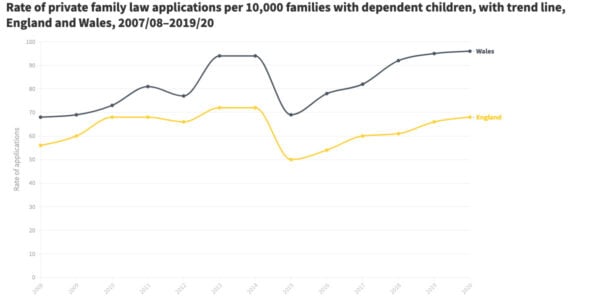Private law children cases relate to disagreements or disputes around a child’s upbringing, such as who they should live with and/or who they should see, with applications made to the family court under the Children Act 1989.
In a new series of maps by the Family Justice Data Partnership, the variation in rates of private law applications across local authorities in England and Wales over an eleven-year period from 2009/10 to 2019/20 is visualised.
The maps show the number of private law applications per 10,000 families with dependent children in the general population at a local authority level: lighter colours indicate lower rates, and darker colours indicate higher rates.
The analysis was undertaken within the Secure Anonymised Information Linkage (SAIL) Databank using data from the Children and Family Court Advisory and Support Services (Cafcass) England and Cafcass Cymru.
What the maps tell us
Taking a closer look at private law children applications cross England and Wales has identified trends and patterns over more than a decade. In both England and Wales an overall upward growth in rates per 10,000 families with dependent children are seen, indicating a sustained increase in the need for support and assistance from family courts over a long period.
This increase, however, was momentarily suspended, as observed in Cusworth et al. 2021, following the introduction of the Legal Aid, Sentencing and Punishment of Offenders Act 2012, which shows the influence of extra-familial factors such as the availability of legal aid, on the level of private law applications. This leads to an important question, is access to justice being inhibited, if so, what steps need to be taken to address this?
A complex picture is observed when looking at rates by local authorities; clear variation exists both between and within all regions of England and Wales year on year ranging from 9 per 10,000 to 183 per 10,000 families. Previous research has indicated a clear link between deprivation and private law applications (Cusworth et al. 2021 and Cusworth et al. 2020) with an over-representation in private law adult parties living in the most deprived areas. There is a need to understand more about the role of deprivation and its interaction with other factors such as conflict, domestic abuse and child protection. In terms of allocation of resources and service development, understanding the level of need for support and the uptake and effectiveness of mediation and other support services in different areas is critical.
Policy responses to court demand must consider local need for assistance. Reviewing these figures alongside rates by court area and research at a family and professional level will help shed further light in this area.
We must bear in mind what these maps don’t tell us. Applications may involve more than one child, so these figures do not give us an indication of the total number of children who are affected by private law cases. They also don’t tell us what the applications were for and whether application type varied across authorities, nor do they tell us the characteristics of the those involved (i.e. age, gender and health). We must also remember that these findings have been drawn using data from Cafcass England and Cafcass Cymru – population level administrative data, designed to meet operational requirements rather than research purposes.
The use of maps to visualise year on year private law rates across local authorities has enabled new insights into private law need and demand. However, further questions are raised about drivers of this demand and its variation.
For further details of private law applications in England and Wales see recent reports in the Uncovering Private Law series by the Family Justice Data Partnership for Nuffield Family Justice Observatory (Cusworth et al. 2021 and Cusworth et al. 2020)






